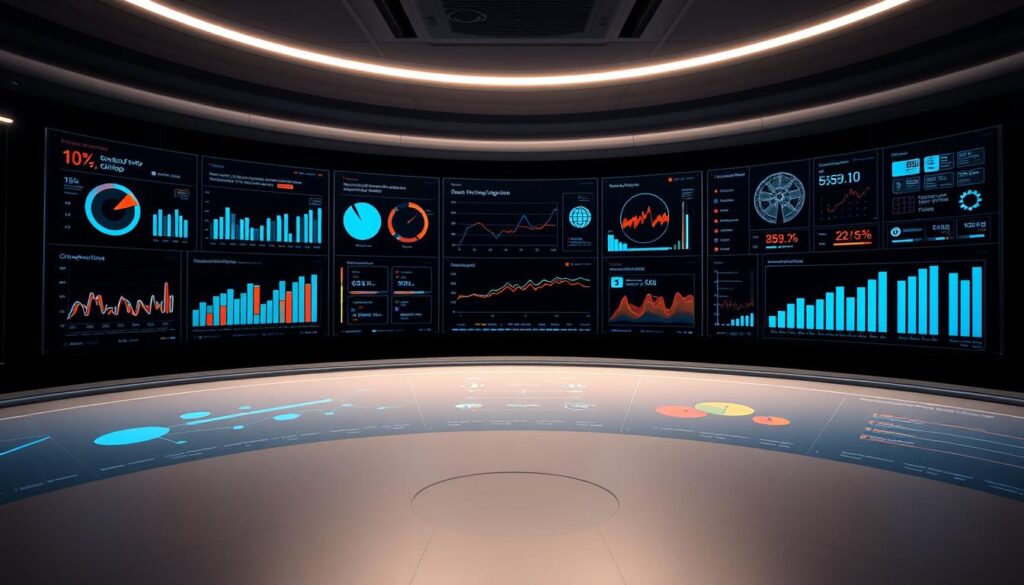Are you struggling to keep track of your project’s progress in real-time?
Unlock real-time visibility into your processes with intuitive dashboard solutions that help you stay on top of your projects. By centralizing relevant data and metrics in one place, you can improve visibility and transparency, making it easier to identify areas that need attention.
Our dashboard solutions enable you to gain insights into your operations, allowing for data-driven decision-making. By presenting information in a clear and concise manner, you can track progress and make informed decisions based on the insights provided. Learn more about the power of data visualization in enhancing your project’s performance.
Key Takeaways
- Improve visibility and transparency with centralized data and metrics.
- Enhance efficiency by automating data collection and analysis.
- Promote collaboration among teams with a shared data platform.
- Gain real-time visibility into project performance for prompt issue identification.
- Make data-driven decisions with clear and concise information.
Introduction to Engineering Monitoring Dashboards
The advent of engineering dashboard software has transformed monitoring and alert systems, making it easier for teams to oversee complex engineering projects efficiently.
Engineering monitoring dashboards are designed to provide a centralized platform for tracking critical metrics and performance indicators. With pre-built dashboards, teams can gain immediate insights into their application’s health, allowing for swift decision-making and action.
For a deeper dive into how software engineering dashboards can enhance your operations, it’s essential to understand the core features and benefits they offer.
| Feature | Description | Benefit |
|---|---|---|
| Real-Time Monitoring | Continuous tracking of system performance | Immediate issue detection |
| Customizable Interfaces | Personalized dashboard layouts | Enhanced user experience |
| Integrated Analytics | Comprehensive data analysis tools | Informed decision-making |
By leveraging engineering dashboard software, teams can significantly improve their monitoring and alert systems, leading to more efficient and effective engineering operations.
Importance of Real-Time Data in Engineering
In the fast-paced world of engineering, real-time data is the key to unlocking efficiency, productivity, and innovation. The ability to analyze and act on data as it’s generated is transforming the way engineering projects are managed and executed.
Benefits of Real-Time Monitoring
Real-time monitoring offers numerous benefits, including enhanced decision-making capabilities, improved predictive maintenance, and increased operational efficiency. By leveraging real-time data visualization, engineers can quickly identify trends, anomalies, and areas for improvement.
One of the primary advantages of real-time monitoring is its ability to facilitate proactive maintenance. By continuously monitoring equipment and systems, engineers can detect potential issues before they become major problems, reducing downtime and improving overall system reliability.
Case Studies: Success Stories
Several organizations have successfully implemented real-time monitoring solutions, achieving significant improvements in their operations. For instance, a leading manufacturing company used a performance analytics tool to monitor their production line in real-time, resulting in a 20% increase in productivity.
| Company | Industry | Outcome |
|---|---|---|
| XYZ Manufacturing | Production | 20% increase in productivity |
| ABC Engineering | Construction | 15% reduction in costs |
| DEF Energy | Energy | Improved predictive maintenance |
By analyzing data in real-time and combining different timeseries datasets, organizations can gain both fast and powerful insights. This enables them to make informed decisions, drive efficiency, and stay competitive in their respective markets.
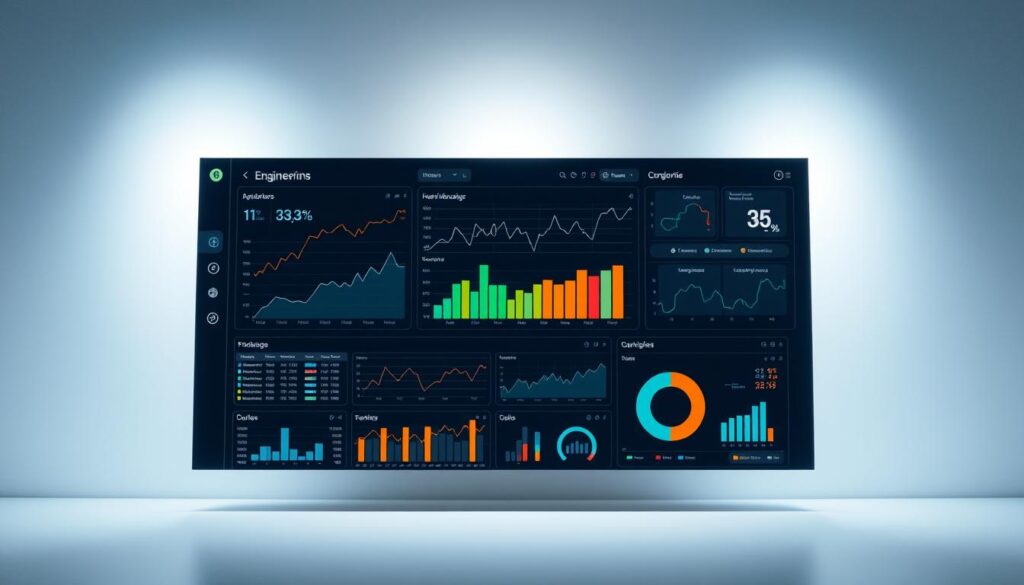
Key Features of Effective Monitoring Dashboards
To maximize the potential of engineering data monitoring solutions, dashboards must be both functional and intuitive. Effective dashboard design is crucial for streamlined engineering monitoring, enabling teams to make data-driven decisions efficiently.
Customizable Interfaces
A key feature of effective monitoring dashboards is their ability to be customized. Users should be able to build and customize dashboards according to their specific needs, adding widgets with different variables, filters, and dimensions for a fully customized view of app performance. This flexibility ensures that the dashboard remains relevant and useful over time.
- Personalize your dashboard to fit your team’s needs.
- Add or remove widgets as necessary to keep the dashboard clutter-free.
- Utilize filters and dimensions to drill down into specific data sets.
Interactive Data Visualizations
Interactive data visualizations are another critical component of effective monitoring dashboards. By presenting data in an interactive format, users can explore their data in more detail, gaining deeper insights into their engineering projects. This interactivity facilitates a more comprehensive understanding of the data, aiding in the identification of trends and potential issues.
- Use interactive charts to visualize complex data.
- Implement drill-down capabilities to access detailed data.
- Utilize hover-over text or other interactive elements to provide additional context.
Integrated Analytics Tools
Finally, effective monitoring dashboards should include integrated analytics tools. These tools enable users to analyze their data directly within the dashboard, streamlining the process of gaining insights and making decisions. By having analytics tools integrated into the dashboard, users can save time and reduce the complexity associated with switching between different applications.
By incorporating customizable interfaces, interactive data visualizations, and integrated analytics tools, engineering teams can create powerful monitoring dashboards that enhance their ability to monitor and analyze their projects effectively.
Choosing the Right Dashboard Software
The right dashboard software can significantly enhance your engineering team’s productivity and decision-making. Streamlining your engineering team’s workflow by sharing and alerting on dashboards is crucial for effective project management.
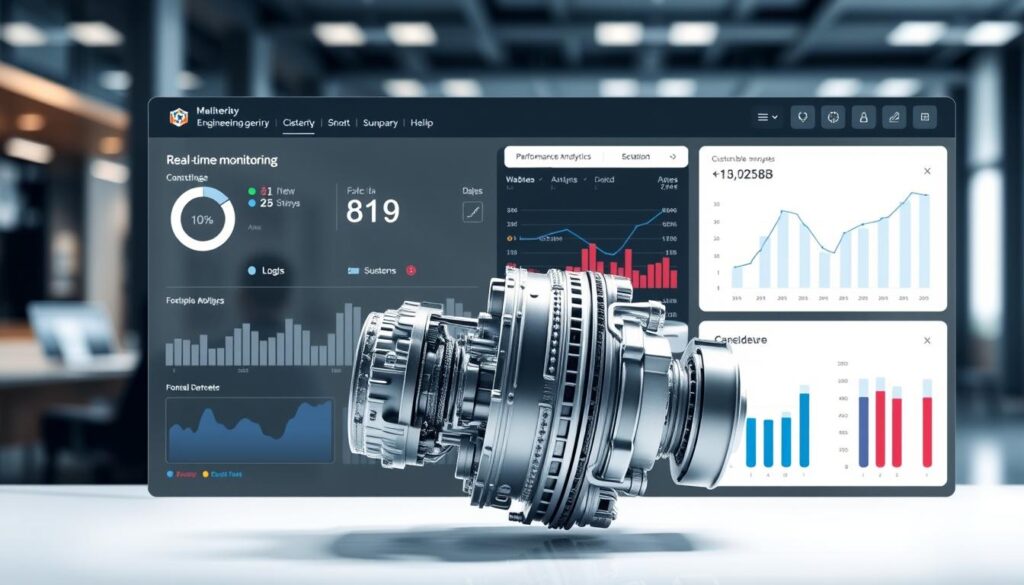
Top Software Solutions on the Market
Several top-notch software solutions are available for engineering monitoring dashboards. Some of the leading options include:
- Tableau: Known for its interactive data visualizations.
- Power BI: Offers robust analytics and integration with Microsoft products.
- Dash: Provides a user-friendly interface for creating custom dashboards.
These solutions offer a range of features, including customizable interfaces and integrated analytics tools, that can cater to the diverse needs of engineering teams.
Criteria for Selection
When selecting a dashboard software, several criteria should be considered. Customization options are crucial, as they allow teams to tailor the dashboard to their specific needs. Other key factors include:
- Ease of use and user interface.
- Integration capabilities with existing systems.
- Scalability to meet future needs.
- Cost and return on investment.
By carefully evaluating these factors, engineering teams can choose a dashboard software that enhances their monitoring capabilities and supports their long-term goals.
Best Practices for Dashboard Design
To get the most out of your engineering monitoring, focus on dashboard design best practices. A well-designed dashboard can simplify complex data, making it easier to share essential insights with leadership and stay on top of critical issues.
Simplify executive reporting by creating reports that are easy to understand and act upon. As the data suggests, “Simplify executive reporting. Reports make it easier to share essential insights with leadership, helping you stay on top of critical issues without missing a beat.”
Simplifying User Experience
A key aspect of dashboard design best practices is simplifying the user experience. This involves creating an intuitive interface that allows users to quickly find the information they need.
- Use clear and concise labels and headings.
- Avoid clutter by limiting the amount of data displayed.
- Use interactive visualizations to enable users to explore data in more detail.
Prioritizing Key Metrics
Another crucial aspect of effective dashboard design is prioritizing key metrics. This involves identifying the most important data points and displaying them prominently.
| Metric | Description | Priority |
|---|---|---|
| System Uptime | Percentage of time the system is operational | High |
| Response Time | Time taken for the system to respond to user input | Medium |
| Error Rate | Number of errors encountered per unit time | High |
By prioritizing key metrics and simplifying the user experience, you can create a dashboard that provides valuable insights and supports informed decision-making.
Integrating Dashboards with Existing Systems
Dashboards become even more powerful when seamlessly integrated with your current monitoring and alert systems. This integration enables a more comprehensive view of your engineering operations, allowing for quicker and more informed decision-making.
Integrating engineering monitoring dashboards with existing systems such as monitoring and alert systems can significantly enhance their functionality. It allows for real-time data synchronization, automated alerts, and a unified view of critical metrics.
“Dashboards let you effortlessly keep track of progress, manage stakeholders, and make quick, informed decisions.”
To achieve a successful integration, consider the following steps:
- Assess your current systems and identify potential integration points.
- Choose a dashboard software that supports integration with your existing infrastructure.
- Configure the integration to enable seamless data exchange between systems.
A well-integrated dashboard system can provide a unified view of your operations, enhancing collaboration and decision-making. For instance, integrating dashboards with monitoring and alert systems can help in promptly identifying and addressing issues.
| Benefits of Integration | Description |
|---|---|
| Real-Time Data Synchronization | Ensures that data across all systems is up-to-date and consistent. |
| Automated Alerts | Triggers notifications based on predefined conditions, enhancing responsiveness. |
| Unified View | Provides a single pane of glass for monitoring and managing operations. |
For more insights on dashboard essentials in industrial engineering, visit Number Analytics Blog.
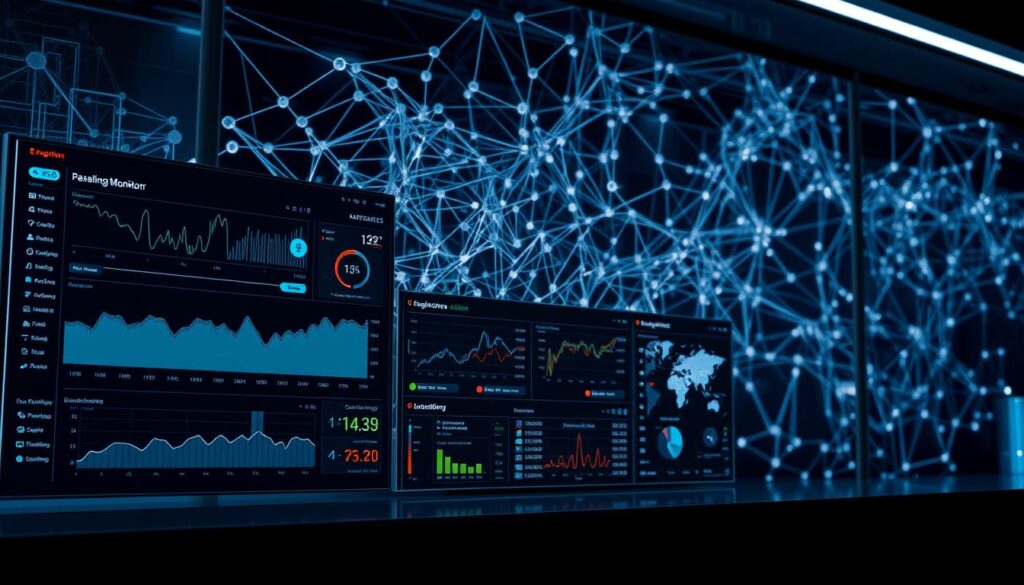
By integrating your dashboards with existing systems, you can unlock their full potential and significantly improve your engineering monitoring capabilities.
Enhancing Collaboration Through Dashboards
Effective collaboration is the backbone of successful engineering projects, and dashboards play a crucial role in facilitating this collaboration. By providing a centralized platform for real-time data visualization, dashboards enable teams to make informed decisions together.
Dashboards allow teams to share insights and work together more effectively. With dashboard customization options, teams can tailor their dashboards to meet their specific needs, ensuring that everyone has access to the information they need.
Sharing Insights Among Teams
One of the key benefits of dashboards is their ability to facilitate the sharing of insights among teams. By providing a common platform for data visualization, dashboards enable teams to collaborate more effectively. For instance, a dashboard can be used to share real-time data on project progress, allowing teams to identify areas that require attention.
“The use of dashboards has revolutionized the way our teams collaborate. We can now share insights and make decisions in real-time, which has significantly improved our project outcomes.”
To illustrate the benefits of dashboards in enhancing collaboration, consider the following table:
| Collaboration Aspect | Without Dashboards | With Dashboards |
|---|---|---|
| Data Sharing | Limited access to real-time data | Real-time data visualization for all team members |
| Decision Making | Delayed decision making due to lack of data | Timely decision making with up-to-date information |
Cloud-Based Solutions
Cloud-based dashboard solutions offer an additional layer of collaboration by enabling teams to access dashboards from anywhere. This flexibility is particularly beneficial for teams working remotely or across different geographical locations.
By leveraging cloud-based solutions, teams can enhance their collaboration and improve project outcomes. As the use of dashboards continues to grow, it’s clear that they will play an increasingly important role in facilitating collaboration in engineering projects.
Common Challenges in Engineering Monitoring
The path to successful engineering monitoring is often paved with challenges. As engineering projects become increasingly complex, the need for effective monitoring solutions grows. However, several common obstacles can impede progress, including data overload and maintaining data accuracy.
Data Overload
One of the significant challenges in engineering monitoring is dealing with the vast amounts of data generated by various sensors and monitoring systems. A staggering 41% of organizations state that metrics and reporting are a core weakness in their governance, risk, and compliance (GRC) processes. This data overload can lead to analysis paralysis, making it difficult to extract meaningful insights.
To overcome this challenge, it’s essential to implement engineering data monitoring solutions that can filter and analyze data effectively. By leveraging advanced analytics tools, organizations can gain a clearer understanding of their project’s performance and make informed decisions.
“The key to successful engineering monitoring lies in the ability to turn data into actionable insights.”
Maintaining Data Accuracy
Another critical challenge is maintaining the accuracy of the data being monitored. Inaccurate data can lead to misguided decisions, potentially jeopardizing project success. Ensuring data accuracy requires robust performance analytics tools that can validate data in real-time.
Organizations can enhance data accuracy by implementing rigorous data validation processes and regularly calibrating monitoring equipment. For more insights on tackling engineering challenges, visit Engineering the Future.
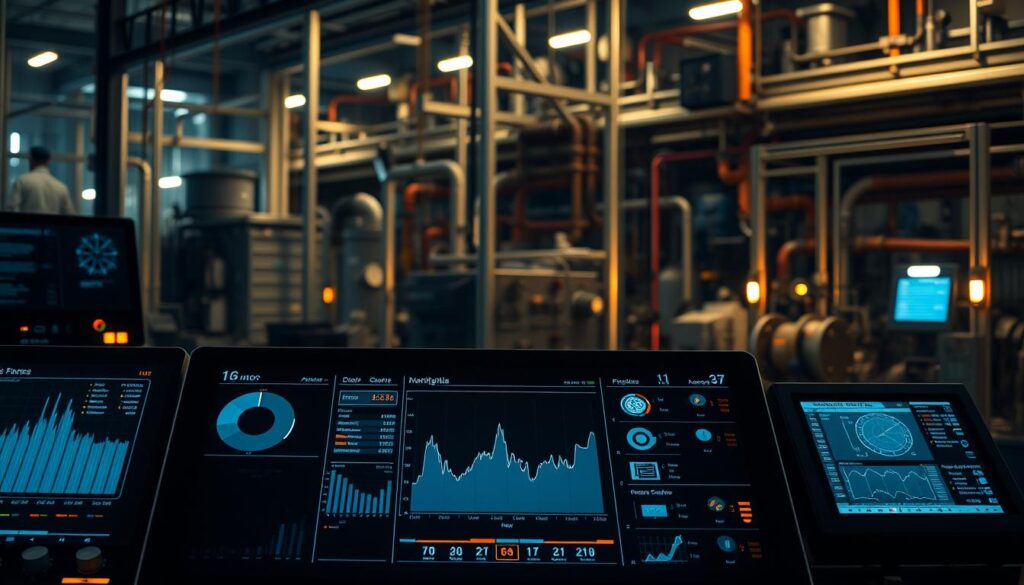
By addressing these common challenges, organizations can significantly improve their engineering monitoring capabilities, leading to more successful project outcomes.
Future Trends in Monitoring Dashboards
Monitoring dashboards are on the cusp of a new era, driven by advancements in AI, machine learning, and predictive analytics. As we look to the future, it’s clear that these technologies will play a pivotal role in shaping the landscape of engineering monitoring.
The integration of AI and machine learning into monitoring dashboards is transforming the way data is analyzed and interpreted. According to a recent study, organizations that have adopted AI-driven monitoring systems have seen a significant improvement in their dashboard performance optimization capabilities.
AI and Machine Learning Integration
AI and machine learning are being used to enhance the functionality of monitoring dashboards, enabling them to learn from data patterns and make predictions. This integration allows for more proactive monitoring and maintenance, reducing downtime and improving overall system efficiency.
For instance, AI-powered monitoring dashboards can analyze historical data to identify potential issues before they become critical, allowing teams to take preventive measures. This proactive approach is a significant step forward in engineering monitoring dashboards, enabling teams to stay ahead of potential problems.
Predictive Analytics
Predictive analytics is another key trend in the evolution of monitoring dashboards. By leveraging advanced statistical models and machine learning algorithms, predictive analytics can forecast future trends and anomalies, enabling teams to make informed decisions.
Understanding how to monitor your data pipelines isn’t just a nice-to-have—it’s essential. As highlighted in a recent article on top features of an effective engineering KPI, the ability to predict and respond to changes in real-time is crucial for maintaining optimal system performance.
| Trend | Description | Benefit |
|---|---|---|
| AI Integration | Enhances data analysis and prediction capabilities | Proactive issue detection and resolution |
| Machine Learning | Improves system efficiency through pattern recognition | Reduced downtime and improved performance |
| Predictive Analytics | Forecasts future trends and anomalies | Informed decision-making and strategic planning |
Training Teams to Use Dashboards Effectively
To get the most out of your monitoring dashboards, it’s essential to train your teams properly. Effective training enables teams to leverage dashboards for improved engineering monitoring, leading to better decision-making and enhanced operational efficiency.
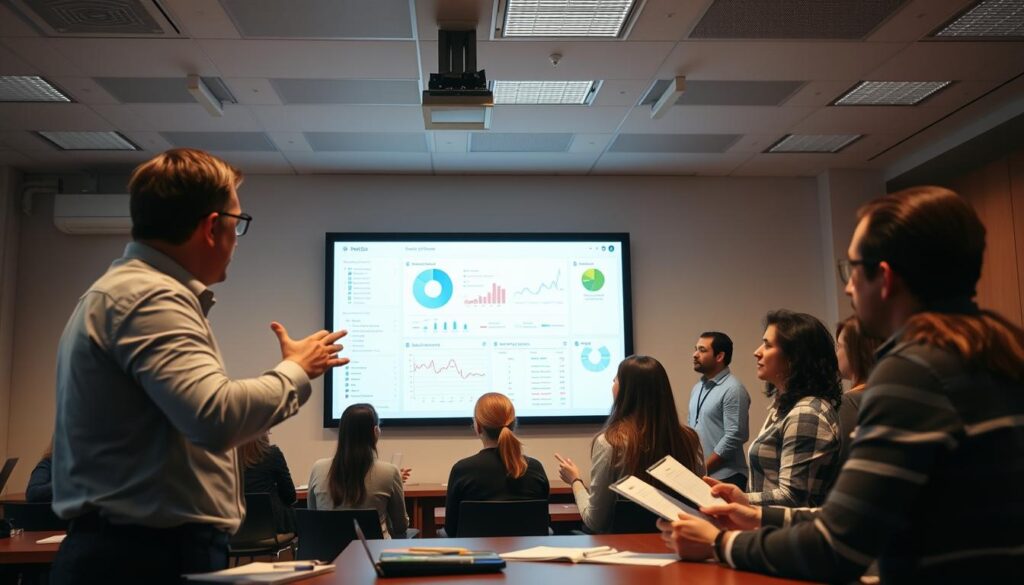
Developing User Guides
Creating comprehensive user guides is a critical step in the training process. These guides should cover the basics of dashboard design best practices, explaining how to navigate the interface, interpret data visualizations, and use integrated analytics tools. By providing detailed instructions and examples, user guides can help reduce the learning curve and ensure that team members can effectively utilize the dashboards.
For instance, the guide could include screenshots of different dashboard components, explaining the purpose of each section and how to customize the view to suit individual needs. Additionally, it could offer troubleshooting tips for common issues, such as understanding alert thresholds in a monitoring and alert system.
Conducting Training Sessions
While user guides are invaluable resources, hosting training sessions can further enhance the learning experience. These sessions provide an opportunity for team members to ask questions, receive hands-on guidance, and learn from the experiences of others. For more information on building effective dashboards, you can refer to resources like this guide on building engineering dashboards.
Training sessions can be conducted in various formats, including in-person workshops, webinars, or online video tutorials. The key is to ensure that the training is engaging, interactive, and tailored to the needs of the team. Data Engineer Academy offers valuable resources that can help you excel in this field, providing insights into best practices and the latest trends in dashboard implementation.
By combining comprehensive user guides with effective training sessions, organizations can ensure that their teams are well-equipped to maximize the benefits of their monitoring dashboards.
Measuring the Success of Your Monitoring Dashboards
Understanding how to measure the success of your monitoring dashboards is essential for data-driven decision-making. To achieve this, it’s crucial to implement a robust measurement strategy that incorporates key performance indicators (KPIs) relevant to your engineering monitoring processes.
Effective measurement involves utilizing a performance analytics tool to track and analyze data from your dashboards. This enables you to assess the performance of your engineering dashboard software and make informed decisions to optimize your monitoring processes.
Key Performance Indicators to Track
To evaluate the success of your monitoring dashboards, consider tracking the following KPIs:
- Dashboard adoption rates among team members
- Frequency of data updates and refresh rates
- User engagement metrics, such as time spent on the dashboard and features used
- Data accuracy and reliability metrics
- Impact on decision-making processes and outcomes
For instance, monitoring stats like daily automated tests conducted can provide actionable visibility into your engineering processes. Drilling down into these metrics can help identify areas for improvement.
| KPI | Description | Target Value |
|---|---|---|
| Dashboard Adoption Rate | Percentage of team members using the dashboard | >80% |
| Data Update Frequency | How often data is updated on the dashboard | Real-time |
| User Engagement | Average time spent on the dashboard per session | >10 minutes |
By tracking these KPIs and leveraging a performance analytics tool, you can gain insights into the effectiveness of your monitoring dashboards and identify opportunities for improvement.
Conclusion: Your Path to Enhanced Engineering Monitoring
Effective engineering monitoring is crucial for making informed decisions and driving project success. By leveraging engineering monitoring dashboards with real-time data visualization, teams can simplify their GRC journey and prioritize tasks more efficiently.
As seen in various case studies, the right dashboard software can significantly enhance collaboration and data accuracy. By choosing the right tools and following best practices for dashboard design, organizations can overcome common challenges in engineering monitoring, such as data overload and maintaining data accuracy.
To enhance your engineering monitoring practices, focus on creating customizable interfaces, interactive data visualizations, and integrated analytics tools. By doing so, you can ensure that your teams are well-equipped to make data-driven decisions and drive project success.
